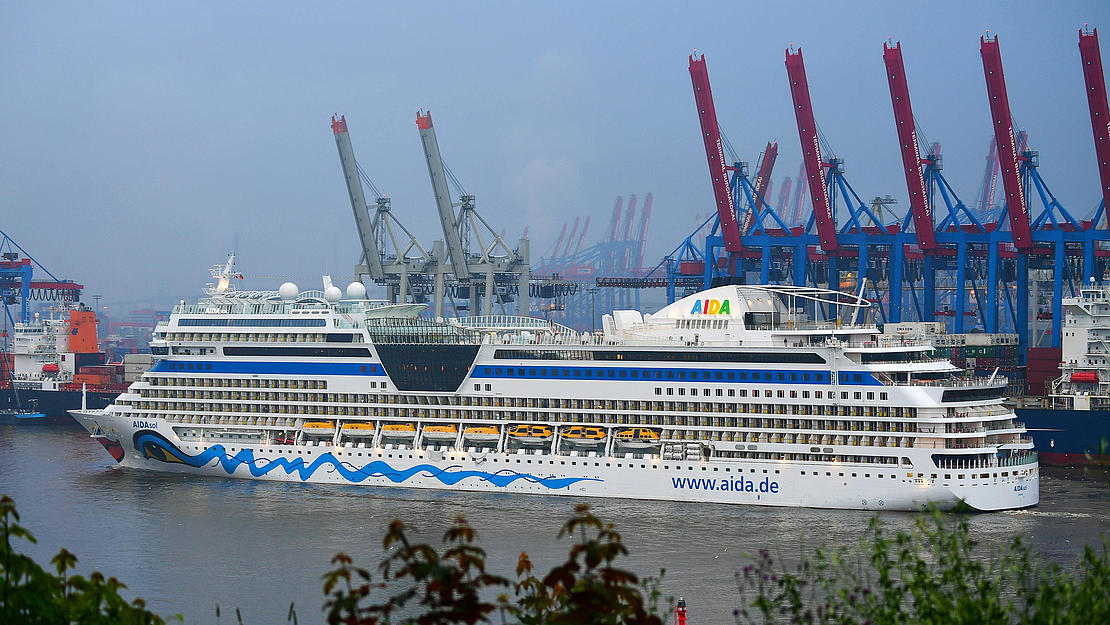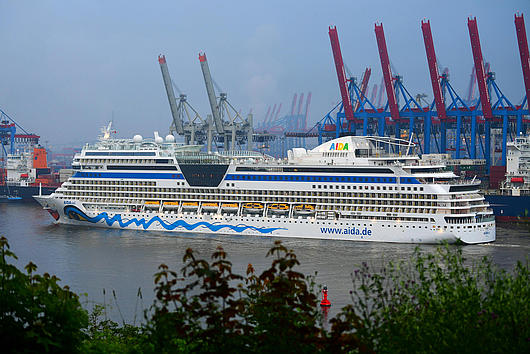19.02.2020
HVCC, Wärtsilä and Carnival achieve real-time data exchange between ship and port
Reliable ship arrivals, more efficient ship handling and port logistics, as well as reduced fuel consumption and emissions – these are the aims of a joint digitalisation project between HVCC Hamburg Vessel Coordination Center, the maritime technology company Wärtsilä and the cruise group Carnival. The details were presented today for the very first time at the Smart Ports Summit in London.

Ports are the hubs of the transport flows that span the globe. By the time ships berth at the terminals, onshore logistics have been meticulously organised and planned right down to the finest detail. This applies to both cargo and passenger ships. If, for example, a cruise ship arrives at the Port of Hamburg, the preparations required for the changeover of 6,000 passengers need to be in place. Dozens of buses, trains, flights, even hundreds of hotel rooms, have been booked and day trips have been arranged. Ship suppliers are waiting to supply the ship with fresh food, consumables and technical materials. A delay to the ship’s arrival can have financial consequences.
As a central, neutral and cross-company coordinating unit, HVCC Hamburg Vessel Coordination Center has been optimising vessel traffic into and out of the Port of Hamburg for over ten years – whether that be a container mega-ship, bulker, cruiser, feeder vessel or inland waterway ship.
In the past year, HVCC has coordinated the arrival of over 3,200 mega-ships in the Port of Hamburg. As part of this passage planning, HVCC determines the ideal arrival time (RTA Requested Time of Arrival) for a ship as it approaches the Elbe. In doing so, it takes into account factors such as berth occupancy, oncoming traffic, tide and weather conditions, and gets the operational overview approved by the relevant authorities – all of this long before the ship begins its transit to Hamburg. The shipping company or ship management can use the RTA data to adjust the ship’s speed and route in order to ensure that the vessel arrives right on time. This also allows terminals and other port service providers to make their plans at the same time. The resulting benefits of such a system are reliable arrival times, optimised port logistics and resource planning, and reductions in fuel consumption and emissions.
Optimised ship calls through digital data exchange
Alongside the maritime technology provider Wärtsilä and cruise group Carnival, HVCC has now further developed its passage planning and has tested a one-of-a-kind, digital solution for just-in-time ship calls. For the first time the direct, real-time data exchange under real-world conditions between port and ship was realized in order to enable a dynamically optimised Hamburg approach.
The first live tests were carried out on the M/S “AIDAperla” and M/S “AIDAsol” – ships which regularly call at the Port of Hamburg. During these tests, the data shared between HVCC and Carnival Maritime’s Fleet Operation Center in Hamburg was fed directly into the cruise ships’ electronic nautical chart (ECDIS) via the Navi-Port digital platform developed by Wärtsilä. The continuous, dynamic, real-time data exchange improves coordination and allows for automatic modifications to a ship’s course and speed should conditions at port change during a voyage. The innovative project is also being supported by the classification society Bureau Veritas to ensure that cybersecurity requirements are met. The team also includes the internationally renowned management consultancy HPC Hamburg Port Consulting with its expertise in port-side project management.
Gerald Hirt, Managing Director of HVCC: “HVCC has always attached great importance to the development of collaborative digital solutions. For us this means ‘passage planning 2.0’ – a further step towards intelligent ship coordination and the digitalisation of port logistics."
Michael Salzmann, Senior Nautical Superintendent, Carnival Maritime: “We are committed to making cruising more sustainable. For this, we welcome the development of new and more efficient technologies. We have tested the solution with two of our ships. The Wärtsilä ships’ onboard navigation systems were connected directly to HVCC, which allowed for continuous communications, resulting in just-in-time arrivals in Hamburg. Outstanding.”
Torsten Büssow, Director, Wärtsilä Voyage: “Wärtsilä’s approach is aimed at eliminating wasteful practices in shipping operations. Close collaboration between industry stakeholders is a key enabler. Once again, this project shows what can be gained when the industry works together in a transparent and cooperative way.”
Najmeh Masoudi, Technology Leader - Smart Ships, Bureau Veritas: “Connectivity is enabling new ways of working. As a class society, Bureau Veritas plays a critical role in helping ensure that the marine industry safely adopts new technologies.”
Following the successful tests in the cruise segment, there are now plans to expand into cargo shipping. Talks have already been held with container shipping companies. “Looking to the future, other port locations could also use this HVCC service,” remarks Hirt. With approximately 3,000 seaports and 100,000 commercial vessels around the world, the potential for further networking is enormous.
Download image

M/S „AIDAsol" arriving at the harbour in Hamburg.
